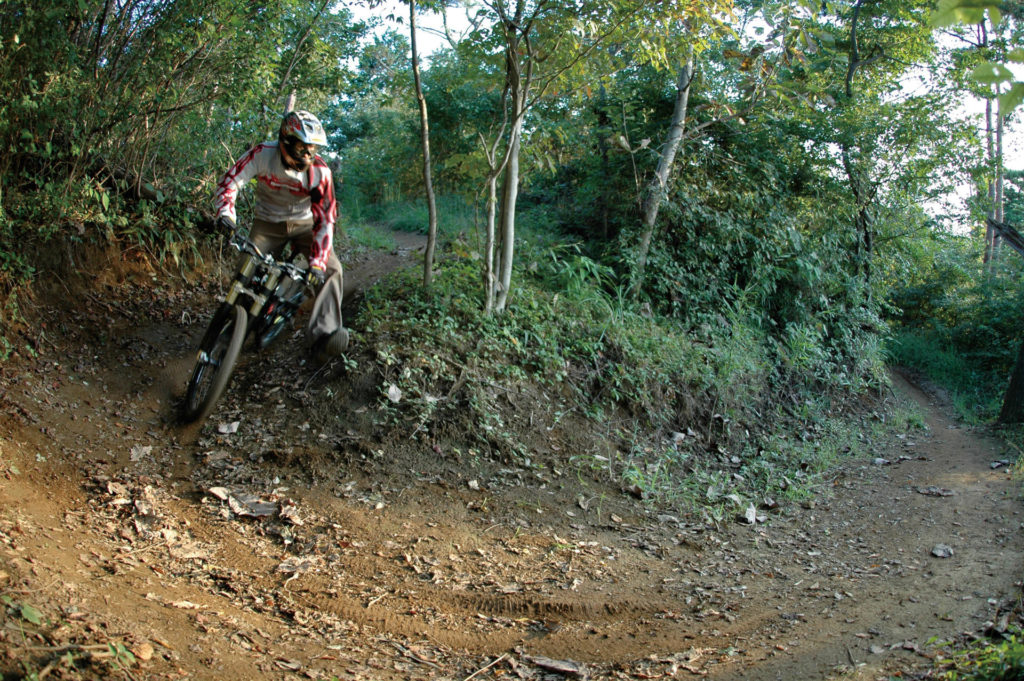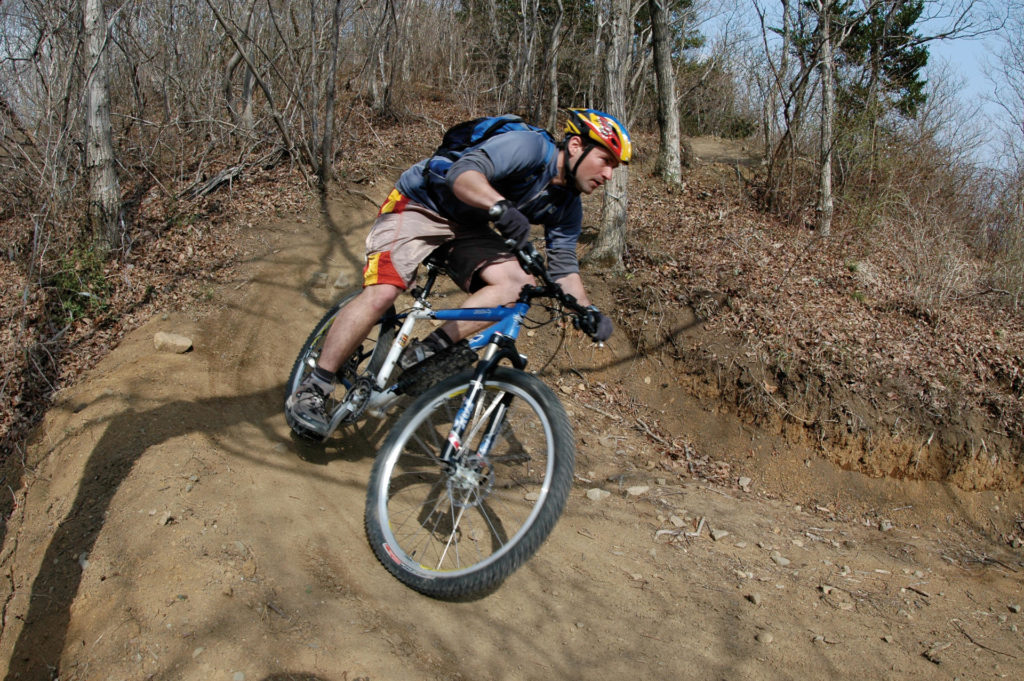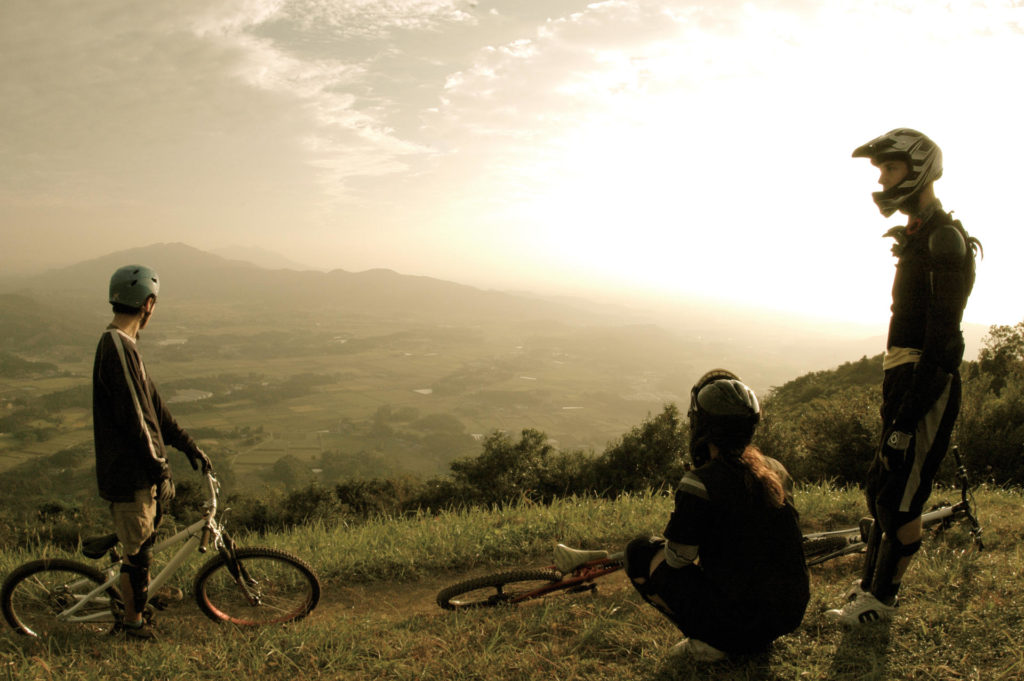Sitting peacefully at Tokyo’s doorstep, Ibaraki Prefecture often goes unnoticed. Yet local mountain bikers have long been blazing the many trails – and word is getting out.

Ibaraki is where the Kanto Plain ends and the forested hills slowly rise into mountains. Not even the Shinkansen stops in what was once an important gateway to the north. Folklore celebrates Mito Komon (水戸黄門) born as Mito Mitsukuni (1628-1700) the lord of the feudal clan of Mito (the old name for Ibaraki Prefecture) as a wise father figure whose innovative ideas turned the quiet countryside into an important commerce center during the Edo era.
Now as I ride my bike through the hilly forest trails, I can see traces of the past. I like to imagine what life must have been like when these same trails were traveled on horseback or on foot by peasants farming in the hills. Leaving the city behind, I see some of the trails, hamlets and valleys seem as if they haven’t changed much since those days, and one of my favorite places to escape to for a weekend is Gozenyama.
Gozenyama is a national park along the Tochigi and Ibaraki border. From Mito, it is only a 40-minute drive to the free campground and parking area next to the Naka River. A bright red bridge serves as a local landmark where hiking trails begin and end.
Most of the guidebooks refer to a loop that starts along a jeep road across from the market and parking area. This road follows a stream meandering up a forested valley. The road continues up to a crest about four kilometers from the start. The hiking trail begins here and follows the ridge along the top of the hills back toward the red bridge. Be aware of hikers and share the trail.
It’s all downhill

For a downhill getaway, one area that has continued to grow in the last few years is Takamine MTB World in Sakuragawa, next to Kasama. Takamine was originally a paragliding center that opened to downhill mountain bikers five years ago.
From the original take-off at the top, you can catch an amazing view of Mt. Kaba, Mt. Tsukuba and the first wave of peaks overlooking the Kanto Plain. On the opposite side lie the mountains near Mashiko Town and, off in the distance, more mountains near Nikko. Each year Takamine adds new courses and features to the bike park.
This year a lot of work has been done to build up the burms and widen the trail. The trail is a lot smoother and faster now, which makes it easier for beginners but also more fun for expert riders. Mountain bikers can also enjoy a new ladder section near the bottom reminiscent of North Shore riding in British Columbia, Canada.
Takamine also offers bicycle tours of the surrounding area. Depending on the season, you can enjoy riding in the countryside and picking strawberries, blueberries, grapes or apples. The tours also visit nearby historical places such as the town of Mashiko, famous for pottery, or the Amabiki Kannon often visited by young mothers in search of guidance near Iwase. You can also have guided MTB tours on backcountry trails through the local mountains.
‘Crash Pads’

Both Gozenyama and Takamine offer overnight accommodations. Gozenyama has some beautiful cabins overlooking the Naka River Valley available in sizes for groups of four, six, 12 and 30 people.
Prices vary accordingly from ¥5,000 to ¥30,000. Cabins are equipped with hot showers and baths, a kitchen, tables and cushions and futons. Nearby there are a couple of onsen where you can unwind. Alternatively, there is also a free camping area next to the red bridge, but it often gets full quickly and facilities are limited.
Takamine has hostel-like accommodations on-site for only ¥1,000 per person. The clubhouse has two tatami rooms with bunk beds and futons for up to 10 people, hot showers, kitchen, living room, TV, DVD and a computer with Internet access. Plusher cabins similar to those at Gozenyama are available in Iwase with a discount for Takamine riders.
Beyond the Bike
Mito is the prefectural capital and it is definitely worth a visit if you have time. The main attraction is Kairakuen, one of the three most famous parks in Japan and, in terms of area, one of the largest urban parks in the world. The wide open space makes Mito feel different than most other cities in Japan and, with its many bike paths and widened sidewalks, cycling is convenient and safe.
From the park, it’s easy to ride along the network of bike paths and back roads all the way to the sea, where you can enjoy eating sushi at the Nakaminato Fish Market and swimming at Oarai Beach.
For off-road riders, there are a few trails around Mito Forest Park maintained by the Bumpy Path Bike Club. They have been expanding and linking new sections of trail and there is now about 15-20 km. of single track. Regular group rides are held on Sundays once a month, and informal rides happen almost every weekend.
The best time to visit is in the spring, when more than 3,000 ume (plum) trees are in bloom. The ume festival begins in mid-February and lasts about one month. The hanami (cherry blossom) festival that follows is also worth checking out. One of the most convenient places to stay is the Kairakuen Youth Hostel a five-minute walk from the park. The hostel is also light on the pocket book, costing only ¥2,000 per person.
Not far from Mito are some great day trips for mountain bikers, all of which are within one hour by train. Hitachi Ota is about 40 minutes on the Hitachi Ota Line from Mito. Here you’ll find a number of historical sites related to Mito Komon.
About a 20-minute ride from the station is Ukari Hachibe MTB course, which hosts the Ukari Hachibe cross-country endurance race twice a year, in spring and fall. The racecourse is open year-round and, unlike many cross-country races in Japan, there is a lot of single track.
Another interesting day trip is Hitachi Omika, only 25 minutes by train from Mito on the Joban Line. Above Hitachi Omika are some scenic hiking courses along a mountain ridge overlooking the sea. The hiking trails continue for almost 15 km., winding through some beautiful forests along the way and increasing in elevation from 250 to 600 meters. Near Omika Station, Hitachi Taga has some great surfing beaches where you can cool after working up a sweat on the trails.
The mountain bike scene in Ibaraki is growing steadily, and Takamine is quickly becoming a meeting place where people can get involved in the riding community. Getting to know other riders from various riding clubs and exploring the countryside together has been one of the highlights of my time in Japan. After five years of riding in Ibaraki, I am still surprised how much more there is to discover.

Getting There
It takes about two hours from Central Tokyo to Mito using is the Joban Expressway. If you are planning to visit Takamine Downhill Park, get off at the Tomobe Interchange (I.C.) and head west along Route 50 for towards Haguro Station. There is a detailed map on the Takamine homepage.
Gozenyama is less than an hour drive north of Mito along Route 123, which follows the Naka River. From the Mito I.C., a more direct route is to head for Johoku town along Route 52. From Johoku, you can connect with route 123 and continue on towards Katsura. A number of towns have amalgamated, and Katsura and Gozenyama are now part of Shirosato town.
To get to Hitachi Ota MTB course, take the Joban highway to Hitachi Minami I.C., about twenty minutes beyond Mito. From there its best to check the Ukari Hachibe homepage for details.
Taking the train in Ibaraki is often much more convenient than driving. If you are traveling by train, take the Joban Line (JR East) from Ueno Station to Tomobe Station (1-1 ½ hours by express) and then about fifteen minutes more to Mito. To get to Takamine, you will need to change trains at Tomobe. From Tomobe, take the Mito Line bound for Oyama. Get off at Haguro Station and from there, you can arrange to be picked up by the MTB park staff.
Train Tips
To carry your bike on the train you need a bike bag to prevent getting dirt or grease on the train (and other people). These come in different styles and cost between ¥5,000 yen and ¥12,000. Most require you to remove one or both wheels and strap them to the frame. JR does not charge extra for carrying bikes in Ibaraki and although rush hour might be a bit of a squeeze, it shouldn’t be a problem. If you plan on carrying a bike on a fast train, it’s best to reserve the seat at the back of the car aisle where there is space behind the seat just wide enough to squeeze a bike into.

Contact Info 連絡先
Takamine MTB World / 高峰MTBワールド: (0296) 75-5503 / 090-3226-2613; www.takamineyama.com
Gozenyama / 御前山: (0295) 55-2222
Iwase/岩瀬: (0296) 76-0952
Kairakuen Youth Hostel / 偕楽園ユースホテル: http://youth-i.com/
Ukari Hachibe / うっかり八兵衛: (0294) 78-0532; www.seizanso.co.jp/mtb/




